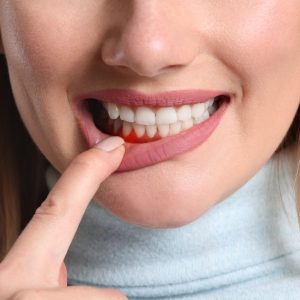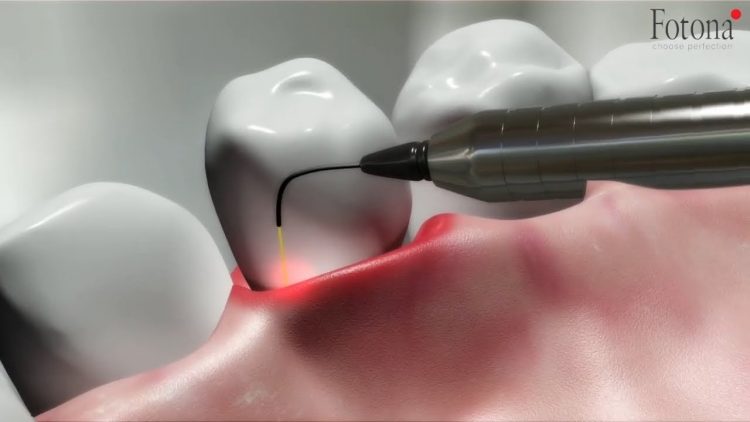 Gum disease is an infection in the tissues that support the teeth, which are usually called the gums or, in medical terms, the periodontium (literally meaning “around the tooth”). Ignoring the disease and leaving the infection untreated can cause the tissue to break down. When the tissue supporting the teeth is lost, they fall out.
Gum disease is an infection in the tissues that support the teeth, which are usually called the gums or, in medical terms, the periodontium (literally meaning “around the tooth”). Ignoring the disease and leaving the infection untreated can cause the tissue to break down. When the tissue supporting the teeth is lost, they fall out.
Causes of gum disease
Gums only stay healthy if your teeth are clean – free of plaque and tartar. Plaque contains bacteria that produce toxins that irritate and damage the gums. As the process develops, gum pockets form.
 Symptoms of gum disease
Symptoms of gum disease
Gum disease starts gradually, with slight redness, tenderness and swelling of the gums, possibly some bleeding and bad breath. This stage is called gingivitis, which is an initial but equally dangerous form of gum disease.
As the disease progresses, it develops into a more severe form called periodontitis. Pockets appear around the base of the teeth. The gums gradually become less connected to the tooth and the tooth falls out. Periodontal disease is also associated with an increased risk of heart disease and stroke, as the infected gum pockets allow bacteria from the mouth to enter the bloodstream.
Factors that increase the risk of gum disease
Although plaque is the main cause of gum disease, certain factors can increase the risk of the disease.
- Smoking or chewing tobacco.
- Diabetes mellitus and other systemic diseases affecting the body’s immune system.
- Heredity.
- Some medicines – contraceptives, antidepressants, blood pressure medication, etc.
- Pregnancy – hormonal changes can also affect the gums, making pregnant women more susceptible to gum disease.
- Stress
- Poor diet
- Teeth cutting, biting
Treatment of gum disease
Professional dental hygiene and good home care can reverse gingivitis. Periodontitis, however, requires more intensive treatment. The conservative treatment for periodontitis is scaling and root planing, where the dentist thoroughly cleans the root surfaces to remove plaque, tartar, and bacterial toxins. If the gum tissue cannot heal with this approach, surgical intervention may be necessary.
Periodontal surgical manipulations
Surgical manipulations performed by a periodontist include gum pocket reduction, crown lengthening and soft tissue grafting.
Pocket reduction procedure (also known as gum lens surgery) is performed when gum pockets are deeper than 5 mm. During the procedure, the gums are separated from the teeth to allow thorough cleaning of the root surfaces below the gum line. The wound is then closed with sutures.
Regeneration procedures aim to restore the periodontal attachment to the teeth by regenerating bone and tissue lost due to gum disease.
Crown lengthening is required before certain tooth restorations. This procedure removes gum tissue, bone, or both to expose more of the tooth’s crown.
Soft tissue grafting is used to cover exposed tooth roots caused by gum recession. Tissue is harvested from the palate and combined with healthy gum tissue to cover and protect the exposed roots.
Laser gum therapy
The use of lasers in the treatment of oral diseases, including gum or periodontal disease, has completely changed the traditional treatment approach, both by reducing the patient’s pain and discomfort in the post-operative period and by reducing the risk of re-infection.
The most modern lasers used in dentistry are designed to address specific clinical problems in the periodontal treatment protocol.
The so-called flap surgery has been used for years to fight the common periodontal disease. Now, thanks to the advantages of new technologies, the laser gum surgery is being used.
After treating the inflamed, infected tissue and eliminating the causes of inflammation, the laser closes the tissue at the same time. Open wounds are not created, which would normally need to be closed with stitches for successful wound healing to take place. In the absence of incisions made with traditionally used instruments that separate the gum tissue from the adjacent jaw, this procedure can be considered minimally invasive.
This technology is particularly suitable for patients at medical risk because it is safe and does not cause local or systemic adverse effects. Especially for diabetic patients, as the laser itself is bactericidal and associated with less bleeding. It is also indicated in patients with renal failure as it is bactericidal and painless, so no post-operative medication is required. It is useful in the treatment of children and the elderly with many other systemic problems such as diabetes, hypertension and other patients who seek to avoid injections or stitches.

How laser gum treatment works
Before treatment, diagnostic tests are performed and documented to assess the depth of the gum pockets and the extent of the infection.
- To minimize discomfort, surface or local anesthesia may be used. This non-invasive technique does not require any additional sedation.
- A laser instrument, about the thickness of three hairs, is inserted between the teeth and gums to remove infected tissue and bacteria. It is designed to fit easily between the gums and teeth.
- Using laser energy, infected tissue in the inner part of the gum pocket is removed (vaporized), while simultaneously destroying harmful bacteria. The laser targets pigmentation, removing only the darker-colored infected tissue while leaving healthy gum tissue intact.
- Tartar is then removed using a combination of laser and ultrasonic instruments. Once the area has been thoroughly cleaned, the heat generated by the laser seals the tissue, forming a blood clot. This helps to block bacteria from re-entering and re-infecting the treated area.
- The procedure is tissue regenerating (rejuvenating). The LANAP procedure also helps the formation of connective tissue and bone between the teeth and gums, which helps reduce the risk of future infections.
Recovery from LANAP surgery often takes less than a day instead of the two to four weeks required for traditional surgery; many patients are able to return to work soon afterwards. Your dentist may also recommend a soft food or liquid diet for one to two days instead of several weeks after gum surgery.
Additional benefits of using a laser
- Less trauma to the oral cavity caused by the traditional scalpel and sutures procedure
- Less pain, bleeding and swelling
- Easier healing and faster recovery
- Improved, longer-lasting results
- Less time spent in the dental chair
The laser does not completely eliminate the use of a scalpel in all cases. In some clinical situations, traditional flap surgery may still be necessary. Although laser treatment reduces the progression of gum disease, excellent oral hygiene and regular visits to the dentist are still necessary to help maintain the results achieved.
 Laser dentistry
Laser dentistry Classical dentistry
Classical dentistry Laser caries treatment
Laser caries treatment Dental prosthetics
Dental prosthetics Dental surgery
Dental surgery Implantology
Implantology Endodontics
Endodontics Orthodontics
Orthodontics Periodontology
Periodontology Pediatric dentistry
Pediatric dentistry Teeth whitening
Teeth whitening Aesthetic dentistry
Aesthetic dentistry Dental hygiene
Dental hygiene Intraoral cosmetology
Intraoral cosmetology Dental consultations
Dental consultations Digital dental radiography
Digital dental radiography